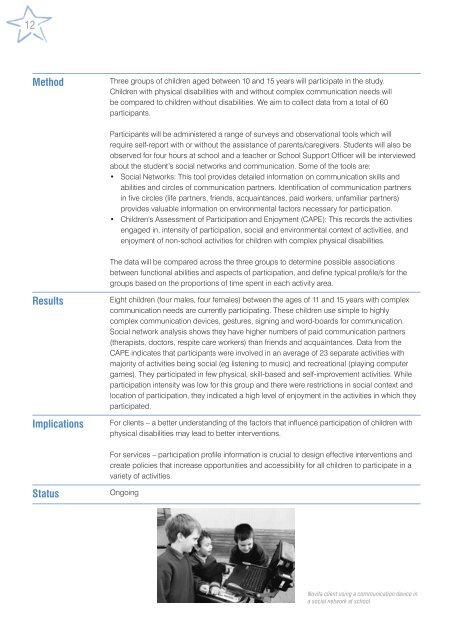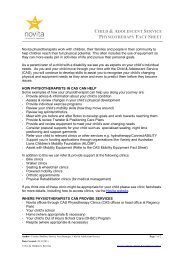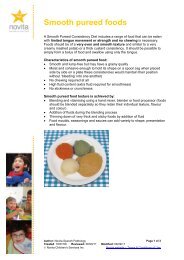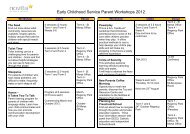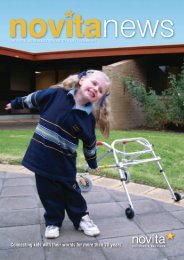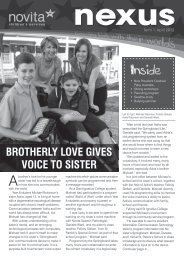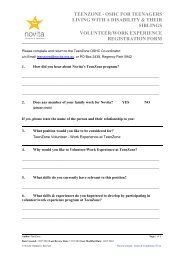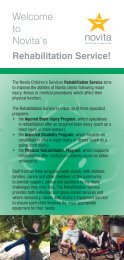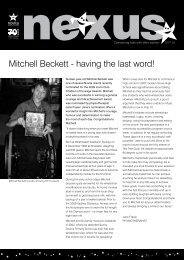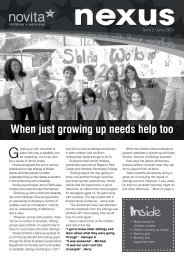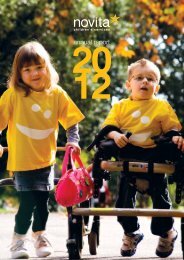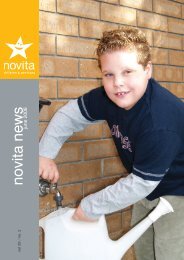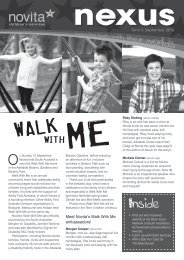Novita Research Report - 2004 to 2007 - Novita Children's Services
Novita Research Report - 2004 to 2007 - Novita Children's Services
Novita Research Report - 2004 to 2007 - Novita Children's Services
- No tags were found...
You also want an ePaper? Increase the reach of your titles
YUMPU automatically turns print PDFs into web optimized ePapers that Google loves.
12MethodThree groups of children aged between 10 and 15 years will participate in the study.Children with physical disabilities with and without complex communication needs willbe compared <strong>to</strong> children without disabilities. We aim <strong>to</strong> collect data from a <strong>to</strong>tal of 60participants.Participants will be administered a range of surveys and observational <strong>to</strong>ols which willrequire self-report with or without the assistance of parents/caregivers. Students will also beobserved for four hours at school and a teacher or School Support Officer will be interviewedabout the student’s social networks and communication. Some of the <strong>to</strong>ols are:• Social Networks: This <strong>to</strong>ol provides detailed information on communication skills andabilities and circles of communication partners. Identification of communication partnersin five circles (life partners, friends, acquaintances, paid workers, unfamiliar partners)provides valuable information on environmental fac<strong>to</strong>rs necessary for participation.• Children’s Assessment of Participation and Enjoyment (CAPE): This records the activitiesengaged in, intensity of participation, social and environmental context of activities, andenjoyment of non-school activities for children with complex physical disabilities.The data will be compared across the three groups <strong>to</strong> determine possible associationsbetween functional abilities and aspects of participation, and define typical profile/s for thegroups based on the proportions of time spent in each activity area.ResultsImplicationsEight children (four males, four females) between the ages of 11 and 15 years with complexcommunication needs are currently participating. These children use simple <strong>to</strong> highlycomplex communication devices, gestures, signing and word-boards for communication.Social network analysis shows they have higher numbers of paid communication partners(therapists, doc<strong>to</strong>rs, respite care workers) than friends and acquaintances. Data from theCAPE indicates that participants were involved in an average of 23 separate activities withmajority of activities being social (eg listening <strong>to</strong> music) and recreational (playing computergames). They participated in few physical, skill-based and self-improvement activities. Whileparticipation intensity was low for this group and there were restrictions in social context andlocation of participation, they indicated a high level of enjoyment in the activities in which theyparticipated.For clients – a better understanding of the fac<strong>to</strong>rs that influence participation of children withphysical disabilities may lead <strong>to</strong> better interventions.For services – participation profile information is crucial <strong>to</strong> design effective interventions andcreate policies that increase opportunities and accessibility for all children <strong>to</strong> participate in avariety of activities.StatusOngoing<strong>Novita</strong> client using a communication device ina social network at school


